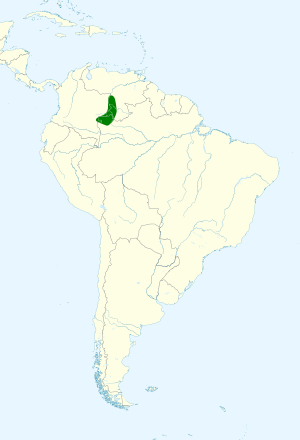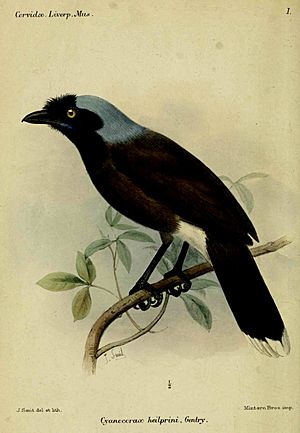Azure-naped jay facts for kids
Quick facts for kids Azure-naped jay |
|
|---|---|
 |
|
| Conservation status | |
| Scientific classification | |
| Genus: |
Cyanocorax
|
| Species: |
heilprini
|
 |
|
The azure-naped jay (Cyanocorax heilprini) is a beautiful blue bird. It belongs to the Corvidae family, which also includes crows and jays. You can find this special bird in countries like Brazil, Colombia, and Venezuela. It loves to live in warm, wet forests or dry, bushy areas.
Contents
What is the Azure-naped Jay?
This bird was first officially described by a scientist named Alan F. Gentry. He studied one bird from a collection in Philadelphia. The name Cyanocorax comes from old Ancient Greek words. Kuanos means "dark blue" and korax means "raven". The second part of its name, heilprini, honors Gentry's friend, Professor Angelo Heilprin.
Different Types of Azure-naped Jays
Scientists have found two main types, or subspecies, of the azure-naped jay:
- C. h. heilprini: This is the original type.
- C. h. hafferi: This type was thought to be a new species in 2013. However, bird experts decided it was still part of the azure-naped jay family.
What Does the Azure-naped Jay Look Like?
The azure-naped jay has a unique look. Its back is a dark brown color. The top parts of its wings and tail are also dark brown. The back of its head and neck are a bright, pretty lavender blue. The front and sides of its head are black. The feathers on its forehead curl forward, forming a short, bushy crest. From its chin down to the middle of its chest, the bird is a dark purplish-grey. Its lower chest and belly are purplish, fading to white near its legs. Its eyes are pale or yellowish-white. Its beak, feet, and legs are black.
Where Do Azure-naped Jays Live?
This bird lives in the Amazon basin. You can find it from southeast Colombia to southwest Venezuela. It also lives in the far northwest of Brazil. It prefers to live in lower tropical areas, usually below 250 meters (about 820 feet) in height. It likes stunted forests, forest edges, and new growth on sandy soils. You might also see it in lighter, open woodlands. Recent studies show that the azure-naped jay mostly lives in special "white sand forests." It is not often found in other nearby forest types.
How Do Azure-naped Jays Behave?
Azure-naped jays are often found in noisy groups. They travel slowly, looking for food at all levels of the forest. They are quite shy when people are around. If they see an intruder, they will make alarm calls. They take turns watching the person before moving away. Sometimes, they just disappear into the plants around them.
What is the Azure-naped Jay's Status?
The azure-naped jay is listed as a species of "Least Concern" by BirdLife International. This means it is not currently in danger of disappearing. It lives over a very large area. Even though its numbers are slowly going down, they are not dropping fast enough to be considered "Vulnerable."
See also
 In Spanish: Chara nuquiazul para niños
In Spanish: Chara nuquiazul para niños



